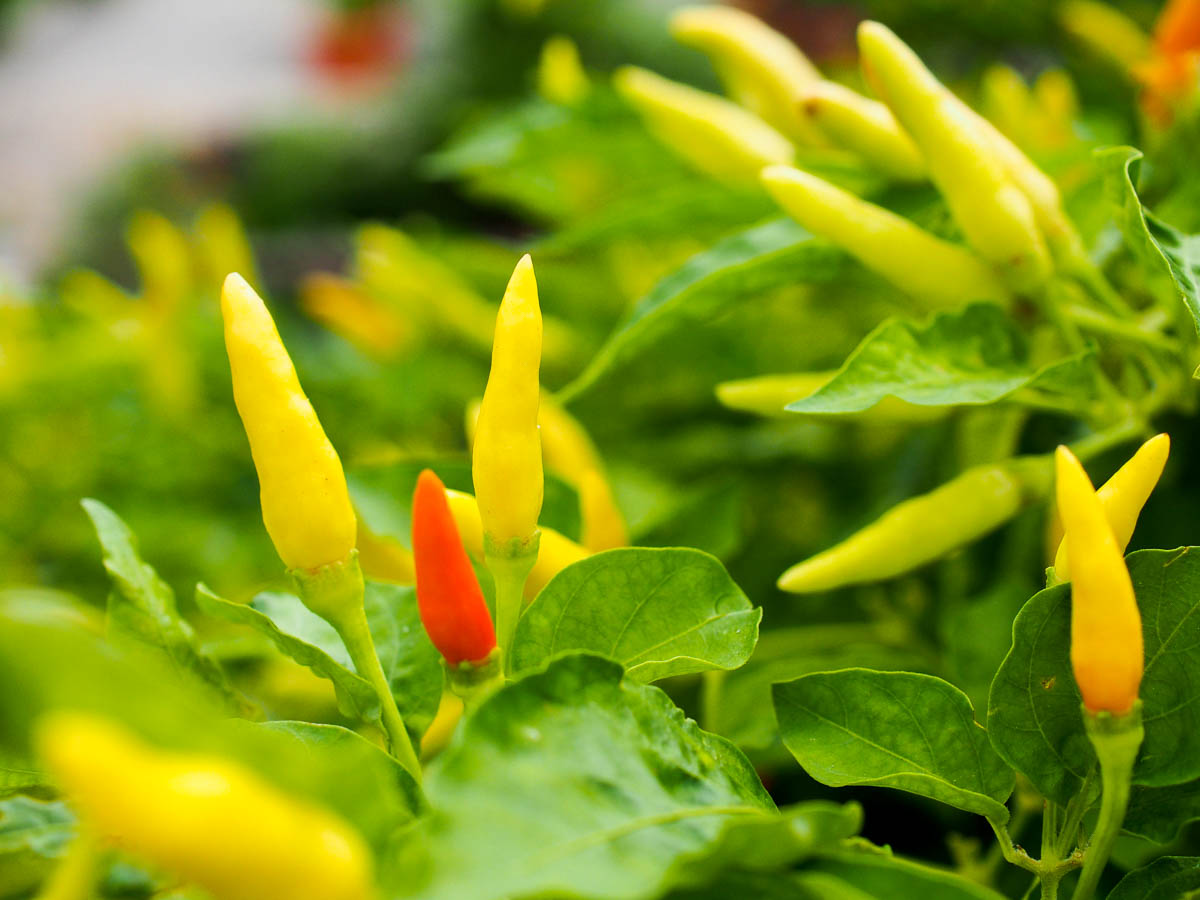Chilli
Chilli (Capsicum annuum)
Other common names: Chilli Pepper, 辣椒

Chillies are an essential plant in most edible gardens across South and Southeast Asia, and are famous for adding a spicy kick to sauces, stews, salads, and more! There are a wide variety of Chilli cultivars, with fruit that vary wildly in colour, shape, and size.
Most varieties of Chilli can be grown as a perennial crop in Singapore, but due to their susceptibility to pests during the rainy season, many are grown as annuals. Most small varieties of chilli can also be grown in pots.
This plant is part of the Solanum or Nightshade family, which includes other popular edible fruits like Brinjal and Tomato.
Sun and soil needs:
.jpg)
This plant does best in full sun gardens with a minimum of 6 hours of direct sunlight. This plant can also grow with 4-5 hours of direct sunlight and at least 6 hours of indirect sunlight, but will produce less fruits.
Plants do best in pots with loamy soil at least 15cm deep, or in true ground.
These plants can get blossom end rot, which shows up as dark, sunken blotches at the end of fruits. It is a symptom of a lack of calcium reaching the fruit, which is usually caused by a lack of water or inconsistent watering. Keep your soil moist but not waterlogged and take care to water more often during the dry season.
Sowing seeds:
Sow seeds individually in a seedling tray filled with potting mix or seedling mix. Lightly mist the soil until damp, once a day. Seeds should sprout within two weeks.
Chilli seeds harvested fresh from ripe fruit are covered in capsaicin oil, which can cause a burning sensation when in contact with the skin, eyes, and lips. Handle fresh chilli seeds with gloves and avoid touching your face to prevent this.
The seedlings will be vulnerable to high heat and heavy rain and are best kept in a sheltered propagation area or a shaded space with around 4 hours of partial or direct sunlight.
Transplanting:
Seedlings will be ready for transplanting into pots or true ground when they have developed 4 or more leaves, or roughly a week or two after germination. Leave 15-30cm between each plant to encourage more growth and better ventilation.
Growing:
Chillies will produce more flowers and thus more fruit when fed with fertilisers high in phosphorus and potassium. Plants can be fertilised once a month after the plant produces its first flower for a fuller crop.
As with all members of the Nightshade family, this plant is buzz-pollinated and produces the most fruit when bees are around to pollinate it. Growing more bee-attracting plants within the garden will encourage pollination.
Shoot tips can be pruned off when the plant is around 30cm tall to encourage branching, with more branches bearing more fruit.
It is a good practice to prune regularly and remove dead leaves and stems to improve ventilation and allow light to reach more of the plant. Regular pruning also decreases the likelihood of pests quickly taking over the plant.
Harvesting:
_jacquelinechua.jpg)
Plants can be harvested for fruits around 3 months after sowing. The best time to harvest the fruit is in the early morning, before 9am.
Both immature and mature Chilli fruits can be eaten and may vary in taste depending on their stage of ripening.
Chilli fruits can be left to ripen and dry on the plant. Dry Chillies can be harvested for seeds to be planted.
Chillies are hot because they produce capsaicin oil, which can cause skin irritation. Very hot varieties like the Carolina Reaper and Ghost Pepper can cause acute pain if handled carelessly. Use gloves while harvesting fruits and avoid touching your face when handling Chillies.
Harvest cycle:
| Growing period | Sowing to germination | Germination to transplanting | Transplanting to first harvest | Total sowing to first harvest |
|---|---|---|---|---|
| Approximate time | 1 to 3 weeks | 2 to 3 weeks | 2 to 3 months | 3 to 4 months |
Check out our sowing and harvest planner to schedule your growing!
Propagation:
Chillies are grown from seed.
Common problems & solutions:

If your plant has few to no flowers, you can fertilise the plant with fertilisers high in phosphorus and potassium. These nutrients encourage root and flower growth, which are important for the plant to produce more fruit.
As with all members of the Nightshade family, this plant is buzz-pollinated and produces the most fruit when bees are around to pollinate it. Growing more bee-attracting plants within the garden will encourage pollination.
Aphids, Mealy Bugs, and Spider Mites often infest the plant if it is waterlogged. Mechanical pest control methods like pruning the infested parts are the best methods for managing these pests.
Fruit flies can lay eggs in the fruit, resulting in larvae damaging the fruit and creating spots on the skin. Wrap your fruit in netting when it starts to develop from a fertilised flower, ideally after all the petals have dropped off.
Sudden exposure heavy rain, like during the Monsoon season, can cause fruits to be knocked off the plant. Protect your plants with a rain shelter during the wet season to prevent this.
Wilting leaves during hot weather is a sign of heat stress. Increase the number of times the plant is watered daily, and apply mulch at the base to prevent water loss.
These plants can get blossom end rot, which shows up as dark, sunken blotches at the end of fruits. It is a symptom of a lack of calcium reaching the fruit, which is usually caused by a lack of water or inconsistent watering. Keep your soil moist but not waterlogged and take care to water more often during the dry season.
This plant is especially vulnerable to root rot caused by waterlogging. It is best to grow the plant in loamy soil with plenty of organic or inorganic soil amendments prevent this.

